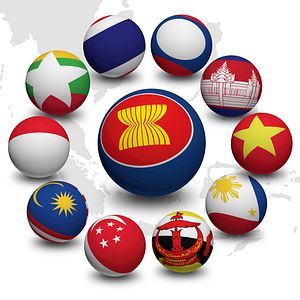When U.S. President Barack Obama hosts leaders from the ten countries of the Association of Southeast Asian Nations (ASEAN) on Monday and Tuesday, he will symbolically reinforce the concept of ASEAN centrality—traditionally the idea that the group’s diverse states should economically integrate and gradually develop a collective voice in the world.
But other kinds of centrality will also be apparent as observers and officials confront regional security issues in which two of ASEAN’s strongest suitors, the United States and China, are on opposing sides.
U.S. officials have, with some legitimacy, sought to deemphasize the U.S.–China narrative in U.S. relations with ASEAN. Speaking Thursday at the Center for American Progress, Deputy National Security Adviser Ben Rhodes described an agenda emphasizing economic growth and innovation and a variety of security challenges, including counterterrorism and disaster response. Rhodes also described the Obama administration’s strategy as using ASEAN as a hub—“a platform to build out a broader series of engagements, and that ultimately is what the East Asian Summit became.”
That East Asia Summit—which now includes the ASEAN 10, plus Australia, China, India, Japan, New Zealand, Russia, South Korea, and the United States—supports another notion of “ASEAN centrality,” in which regular ASEAN meetings become occasions for even broader summits at the same time. Obama became the first U.S. president to attend the East Asia Summit in 2011, on the same trip during which he announced a greater emphasis on the Asia-Pacific.
The U.S. engagement with ASEAN as a group is, on its own, broad and evolving. But any time the U.S. media see East Asia on the agenda, the China story of the day comes to mind. In a briefing for reporters, when the first questioner raised ASEAN countries’ diverse relationships with China, both the chief White House Asia adviser and the top U.S. diplomat for the region said the summit is “not about China.”
Clearly, that’s not entirely true. Drawn out by a question on the South China Sea, Assistant Secretary of State Daniel Russel described the present summit, which will last a full day and does not come with the usual structured agenda, as a unique opportunity:
What the leaders can do that they often are unable to do, partly due to the constraints of time, is to delve a little more deeply into what they see as the realm of the possible in terms of lowering tensions in the South China Sea and setting up a dynamic that can build on, for example, the decision of the tribunal in the Hague.
Here, Russel is referring to the legal case brought by the Philippines under the UN Convention on the Law of the Sea (UNCLOS) that challenges Chinese claims in the South China Sea. Though the arbitral tribunal found that it has jurisdiction to decide a number of the questions raised by the Philippines, the Chinese government has declared the proceedings illegitimate, called the tribunal’s decision on jurisdiction “null and void,” and refused to participate in the process.
It is entirely reasonable for regional governments to discuss what might happen after the tribunal releases its decision, but doing so is surely, at least partly, “about China.”
The reality is that ASEAN is a unique institution that plays a central role in convening regional governments, coordinating their efforts, and confronting challenges. And in East Asia, if not everywhere in the world, China is involved in opportunities, challenges, initiatives, and disputes. The scale of Chinese economic, security, and diplomatic efforts is one reason ASEAN has gained such prominence.
Holding this month’s summit in California at Sunnylands, where Obama hosted Chinese President Xi Jinping for their first major meeting in 2013, sends an unmistakable signal that the Obama administration places an emphasis on strong independent ties with ASEAN as a group.
Administration officials in briefings said part of the intention is to cement the U.S.–ASEAN relationship so that the next president can build on the Obama team’s efforts. That seems true, but this kind of diplomatic courtship also raises expectations of a continued U.S. commitment. From the current administration’s perspective, this move can help to lock in deeper engagement. For the next president, raised expectations would make a shift of priorities away from ASEAN more costly in terms of U.S. credibility.
With the presidential campaign wide open and even the candidate closest to the administration, former Secretary of State Hillary Clinton, now opposing the Trans-Pacific Partnership, this summit should be seen in the context of efforts to make Obama’s policies stick.
ASEAN is not just central to its members’ priorities or playing off the two Pacific giants of the United States and China. For two days, ASEAN is also central to struggles over the future of U.S. foreign policy.
Graham Webster (@gwbstr) is a researcher, lecturer, and senior fellow of The China Center at Yale Law School. Sign up for his free e-mail brief, U.S.–China Week.

































